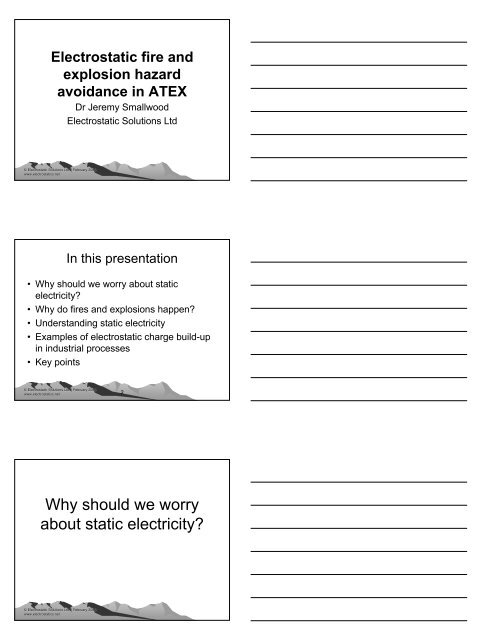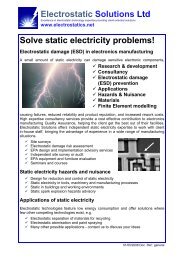Why should we worry about static electricity? - Electrostatic ...
Why should we worry about static electricity? - Electrostatic ...
Why should we worry about static electricity? - Electrostatic ...
You also want an ePaper? Increase the reach of your titles
YUMPU automatically turns print PDFs into web optimized ePapers that Google loves.
Electro<strong>static</strong> fire and<br />
explosion hazard<br />
avoidance in ATEX<br />
Dr Jeremy Smallwood<br />
Electro<strong>static</strong> Solutions Ltd<br />
© Electro<strong>static</strong> Solutions Ltd 2 February 2006<br />
www.electro<strong>static</strong>s.net<br />
In this presentation<br />
• <strong>Why</strong> <strong>should</strong> <strong>we</strong> <strong>worry</strong> <strong>about</strong> <strong>static</strong><br />
<strong>electricity</strong><br />
• <strong>Why</strong> do fires and explosions happen<br />
• Understanding <strong>static</strong> <strong>electricity</strong><br />
• Examples of electro<strong>static</strong> charge build-up<br />
in industrial processes<br />
• Key points<br />
© Electro<strong>static</strong> Solutions Ltd 2 February 2006<br />
www.electro<strong>static</strong>s.net 2<br />
<strong>Why</strong> <strong>should</strong> <strong>we</strong> <strong>worry</strong><br />
<strong>about</strong> <strong>static</strong> <strong>electricity</strong><br />
© Electro<strong>static</strong> Solutions Ltd 2 February 2006<br />
www.electro<strong>static</strong>s.net
Maize starch dust explosion<br />
Vaksdal, Norway,<br />
April 1982<br />
Photographer:<br />
A.M.Fosse<br />
From R.K. Eckhoff<br />
(1991) Dust<br />
Explosions in the<br />
process industries<br />
© Electro<strong>static</strong> Solutions Ltd 2 February 2006<br />
www.electro<strong>static</strong>s.net 4<br />
Fire when refuelling car<br />
In the USA<br />
Fortunately<br />
this is<br />
unlikely to<br />
happen in the<br />
UK!<br />
© Electro<strong>static</strong> Solutions Ltd 2 February 2006<br />
www.electro<strong>static</strong>s.net 5<br />
<strong>Why</strong> do fires and<br />
explosions happen<br />
© Electro<strong>static</strong> Solutions Ltd 2 February 2006<br />
www.electro<strong>static</strong>s.net
Fire triangle for <strong>static</strong> <strong>electricity</strong><br />
SPARK<br />
FIRE<br />
EXPLOSION<br />
FIRE<br />
EXPLOSION<br />
AIR<br />
FUEL<br />
© Electro<strong>static</strong> Solutions Ltd 2 February 2006<br />
www.electro<strong>static</strong>s.net 7<br />
The flammable atmosphere<br />
• The fuel could be<br />
– Vapours<br />
–Dusts<br />
– Droplets of liquid (mist)<br />
– A mixture of vapours and other materials<br />
• The fuel is usually essential to operations<br />
• In some cases the atmosphere may be<br />
inerted e.g. with nitrogen or CO2<br />
© Electro<strong>static</strong> Solutions Ltd 2 February 2006<br />
www.electro<strong>static</strong>s.net 8<br />
Minimum Ignition Energy (MIE)<br />
• To ignite a flammable mixtures the ESD energy must<br />
exceed the material Minimum Ignition Energy (MIE)<br />
• Different flammable mixtures have different MIE<br />
• MIEs of gases and hydrocarbon vapours in air are often<br />
around 0.1- 0.3 mJ<br />
• Some vapour MIEs can be as low as 0.02 mJ<br />
– hydrogen-air<br />
– ethylene-air<br />
– oxygenated mixtures<br />
• Dust clouds can have MIE from < 1mJ upwards<br />
– MIE varies with particle sizes and other factors<br />
© Electro<strong>static</strong> Solutions Ltd 2 February 2006<br />
www.electro<strong>static</strong>s.net 9
Different types of ESD have<br />
different ability to ignite materials<br />
ESD type<br />
Spark<br />
Propagating<br />
brush<br />
Brush<br />
Cone<br />
Corona<br />
Where it occurs<br />
Bet<strong>we</strong>en two conductors<br />
From insulator backed<br />
by a conductor<br />
From insulators<br />
Highly charged insulating<br />
powder cones in silos<br />
Sharp edges on charged<br />
conductors<br />
Will ignite<br />
Gas mixtures and<br />
dusts<br />
Gas mixtures and<br />
dusts<br />
Gas mixtures<br />
Gas mixtures and<br />
low MIE dusts<br />
Not usually<br />
incendive<br />
© Electro<strong>static</strong> Solutions Ltd 2 February 2006<br />
www.electro<strong>static</strong>s.net 10<br />
Understanding <strong>static</strong><br />
<strong>electricity</strong><br />
© Electro<strong>static</strong> Solutions Ltd 2 February 2006<br />
www.electro<strong>static</strong>s.net<br />
Where does electro<strong>static</strong> charge<br />
come from<br />
• Every material is made up of charge<br />
– Negative electrons<br />
– Positive atomic nuclei<br />
• These charges are normally present in<br />
balance, and their effects cancel<br />
– If there is a local imbalance <strong>we</strong> may see<br />
<strong>static</strong> <strong>electricity</strong> effects<br />
• charge transferred bet<strong>we</strong>en materials<br />
in contact<br />
– electrons flow from one material to the<br />
other<br />
• materials separate and take equal and<br />
opposite polarity (positive and<br />
negative) charge<br />
+<br />
+<br />
+<br />
+<br />
+<br />
+<br />
+<br />
+<br />
▬<br />
▬<br />
▬<br />
▬<br />
▬<br />
▬<br />
▬<br />
▬<br />
© Electro<strong>static</strong> Solutions Ltd 2 February 2006<br />
www.electro<strong>static</strong>s.net 12
<strong>Why</strong> don’t t <strong>we</strong> always get <strong>static</strong><br />
charge build-up<br />
up<br />
• if charge moves away faster<br />
than it is generated, then no<br />
problem<br />
• if charge is generated faster<br />
than it can move away then<br />
build-up occurs<br />
– High voltages quickly arise<br />
No<br />
problem Problem !<br />
© Electro<strong>static</strong> Solutions Ltd 2 February 2006<br />
www.electro<strong>static</strong>s.net 13<br />
Conductors and grounding<br />
• Conducting materials such as metal allow<br />
<strong>static</strong> <strong>electricity</strong> to move around<br />
• We can “ground” or “earth” a conductor by<br />
connecting it to electrical earth by way of a<br />
wire<br />
• The human body is a conductor and may<br />
need to be grounded<br />
© Electro<strong>static</strong> Solutions Ltd 2 February 2006<br />
www.electro<strong>static</strong>s.net 14<br />
Insulators prevent <strong>static</strong> charge<br />
moving away<br />
• Insulators cannot conduct <strong>static</strong> <strong>electricity</strong> away<br />
• Insulators encourage <strong>static</strong> charge to build-up!<br />
• Grounding an insulator does not work as the<br />
charge cannot move from the insulator<br />
• Insulators can prevent charge moving from an<br />
isolated conductor<br />
• Use of insulators in a hazard Zone is often<br />
restricted as they may be the source of ESD<br />
© Electro<strong>static</strong> Solutions Ltd 2 February 2006<br />
www.electro<strong>static</strong>s.net 15
Some examples of insulators<br />
• Plastic and rubber<br />
– Packaging, polythene sheet and wrap, bags,<br />
boxes<br />
– Shoe soles<br />
– Floors<br />
– Trolley wheels<br />
• Glass (sometimes)<br />
• Air and gases<br />
© Electro<strong>static</strong> Solutions Ltd 2 February 2006<br />
www.electro<strong>static</strong>s.net 16<br />
Demonstrations<br />
• Charging of plastics<br />
• Charging of metal plate without touching it<br />
• The effect of grounding the conductor<br />
• Voltages on people<br />
• The effect of grounding the person<br />
© Electro<strong>static</strong> Solutions Ltd 2 February 2006<br />
www.electro<strong>static</strong>s.net 17<br />
Examples of electro<strong>static</strong><br />
charge build-up up in industrial<br />
processes<br />
© Electro<strong>static</strong> Solutions Ltd 2 February 2006<br />
www.electro<strong>static</strong>s.net
Contact charging in processes<br />
• Charges are separated wherever two<br />
materials are in contact<br />
– Highly insulating liquids or solids encourage<br />
charge build-up<br />
• In pipes, containers or process equipment<br />
• Poured and blown powder particles can<br />
give high charge levels<br />
• A person walking or wiping a plastic<br />
equipment surface<br />
© Electro<strong>static</strong> Solutions Ltd 2 February 2006<br />
www.electro<strong>static</strong>s.net 19<br />
Rate of charge generation<br />
• Charge generation<br />
increases with<br />
– Area of contact<br />
– Rate of “breaking<br />
contact”<br />
For the polymer film passing<br />
over the roller, more charge will<br />
be generated as the roller speed<br />
is increased.<br />
– Rubbing action<br />
roller<br />
Polymer film<br />
© Electro<strong>static</strong> Solutions Ltd 2 February 2006<br />
www.electro<strong>static</strong>s.net 20<br />
Some processes generate high<br />
charge levels<br />
•Seiving<br />
•Pouring<br />
• Scroll feed transfer<br />
•Grinding<br />
•Micronising<br />
• Pneumatic conveying<br />
• Triboelectric powder coating<br />
© Electro<strong>static</strong> Solutions Ltd 2 February 2006<br />
www.electro<strong>static</strong>s.net 21
Charging in flowing liquids<br />
• Charge separates bet<strong>we</strong>en the<br />
liquid and the pipe wall<br />
• When an insulating liquid flows<br />
away, it takes the charge with it<br />
• Some conditions increase<br />
charge generation<br />
– Immiscible solid and liquid<br />
particles<br />
– Stirring and mixing, turbulence<br />
– Splashing<br />
– Filters<br />
Liquid<br />
flow<br />
Pipe wall<br />
▬<br />
▬<br />
▬<br />
▬<br />
▬<br />
▬<br />
▬<br />
▬<br />
+<br />
+<br />
+<br />
+<br />
+<br />
+<br />
+<br />
+<br />
liquid<br />
+<br />
+<br />
+<br />
+<br />
+<br />
+<br />
+<br />
+<br />
▬<br />
▬<br />
▬<br />
▬<br />
▬<br />
▬<br />
▬<br />
▬<br />
© Electro<strong>static</strong> Solutions Ltd 2 February 2006<br />
www.electro<strong>static</strong>s.net 22<br />
Avoiding ignition risk<br />
• Identify and control zones of flammable<br />
atmosphere<br />
– Inerting can be used to eliminate flammable<br />
atmosphere if necessary<br />
• Where flammable atmosphere is possible,<br />
eliminate ESD sources<br />
– In the case of dusts the Minimum Ignition Energy<br />
(MIE) will have to be assessed to determine the level<br />
of risk<br />
• If in doubt take specialist advice<br />
© Electro<strong>static</strong> Solutions Ltd 2 February 2006<br />
www.electro<strong>static</strong>s.net 23<br />
Exploding icing sugar<br />
Courtesy<br />
Dr D K<br />
Davies<br />
© Electro<strong>static</strong> Solutions Ltd 2 February 2006<br />
www.electro<strong>static</strong>s.net 24
Assess use of insulators<br />
• Avoid insulators that could charge up<br />
dangerously or cause conductors to become<br />
isolated<br />
• Plastic equipment and packaging<br />
• Rubber<br />
• Epoxy floors<br />
• Charged insulators give brush discharges that<br />
could ignite flammable vapours<br />
– Only small areas of insulating surfaces are allo<strong>we</strong>d in<br />
Zone 0 and 1<br />
Specific guidance for many industrial<br />
situations is given in CLC/TR 50404:2003<br />
© Electro<strong>static</strong> Solutions Ltd 2 February 2006<br />
www.electro<strong>static</strong>s.net 25<br />
Ground any conductors including<br />
people<br />
• Avoid having isolated metal parts that could be<br />
charged by induction or triboelectrification<br />
• Ground all conductors of any significant size<br />
– People are large conductors and must often be<br />
grounded through shoes and flooring!<br />
• Charged conductors give sparks that may ignite<br />
vapour or dust clouds<br />
• Charged insulators Induced voltages in isolated<br />
metal parts, causing sparks<br />
Specific guidance for many industrial<br />
situations is given in CLC/TR 50404:2003<br />
© Electro<strong>static</strong> Solutions Ltd 2 February 2006<br />
www.electro<strong>static</strong>s.net 26<br />
Key points (1)<br />
• For ignition of a flammable materials 3<br />
things must be present<br />
– Fuel<br />
– Air (oxygen)<br />
– The ignition source (ESD)<br />
• The energy of the ESD must be greater<br />
than the material Minimum Ignition Energy<br />
• Different types of ESD have different<br />
ability to ignite vapours or dusts<br />
© Electro<strong>static</strong> Solutions Ltd 2 February 2006<br />
www.electro<strong>static</strong>s.net 27
Key points (2)<br />
• All materials can generate <strong>static</strong> electric<br />
charges<br />
• Static builds up if it can’t dissipate fast<br />
enough<br />
• Charge on insulating materials cannot<br />
move and tends to build up – insulators<br />
cannot be grounded<br />
• Charges on conductors can be released<br />
safely to earth by grounding<br />
© Electro<strong>static</strong> Solutions Ltd 2 February 2006<br />
www.electro<strong>static</strong>s.net 28<br />
Key points (3)<br />
• The main ESD control methods are<br />
– Avoid using insulators that could charge up<br />
and cause ESD<br />
– Be sure all conductors within a hazard Zone<br />
are grounded<br />
– Grounding people through conductive or<br />
dissipative foot<strong>we</strong>ar and flooring<br />
Specific guidance for many industrial situations is<br />
given in CLC/TR 50404:2003<br />
© Electro<strong>static</strong> Solutions Ltd 2 February 2006<br />
www.electro<strong>static</strong>s.net 29<br />
References and further reading<br />
CENELEC. Electro<strong>static</strong>s – Code of practice for the<br />
avoidance of hazards due to <strong>static</strong> <strong>electricity</strong>. CLC/TR<br />
50404:2003<br />
CEN. Non-Electrical equipment for potentially<br />
explosive atmospheres – Part 1: Basic method and<br />
requirements. BS EN 13463-1:2001<br />
CENELEC. Electrical apparatus for explosive gas<br />
atmospheres. Part 0: General requirements.<br />
BS EN60079-0:2004<br />
© Electro<strong>static</strong> Solutions Ltd 2 February 2006<br />
www.electro<strong>static</strong>s.net 30



